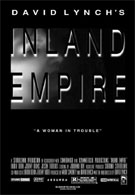“What is Inland Empire about?” It’s the inevitable, make or break question that everyone asks, and it’s a question that is asked before and after most of David Lynch’s films. Inland Empire is no different; in fact, it’s Lynch at his most extreme and inspired. Don’t let the seemingly incoherent story fool you, there are layers upon layers of meaning that will be unfolding for years to come.
The difficulty of Inland Empire, and Lynch himself, is that he does not make any concessions for his audience. The audience has to work for every plot detail and metaphor, which is not a simple task when watching a filmmaker who knows more about making films than most of us will ever know about watching them. On the surface, Inland Empire is about the duality of acting. Laura Dern plays an actress who lands a huge role opposite Justin Theroux, who plays a hot-shot, womanizing actor. As Dern becomes consumed by her character and her relationship, both professionally and personally, with Theroux, she begins to lose sight of where the fictional character stops and reality begins.
Lynch loves to play with our assumptions and knows that an audience’s attention is caught up in the moment, moments like a rehearsal read-through between Dern and Theroux. We know that they are actors and they are rehearsing but halfway through, something changes. We begin to believe their character, their dialogue. The line between what we know is false and cinematic reality no longer exists. It’s that simple assumption that Lynch plays with for the duration of the film. Just as Dern doesn’t know when she’s acting in the film within the film or when she is just being, we don’t either. While Lynch is commended for crafting a film that skews the lines of cinematic reality so well, it wouldn’t have worked without a powerful performance from Dern. She is believable even when we don’t know who the hell she is.
The confusion of realities permeates Dern’s story to the point where Lynch is commenting on the state of his own film. In the most avant-garde aspect, three rabbit/human hybrids sit in a living room and engage in fairly obtuse dialogue, at which point a ridiculous laugh track interrupts the conversation. These scenes are more supplementary to the film, rather than essential to the brunt of the story. While the dialogue does provide some insight into character motives, these scenes are more of a commentary on us, the audience. When faced with a moment that seems absurd and pointless, we laugh and write it off. Instead of trying to determine what the filmmaker is saying, we chalk everything up to absurdity and rob it of its meaning.
However, Inland Empire is not a film that should be dismissed or panned. It is a film that demands your intelligence, attention and patience. Although the absurdity is humorous at times, the tone of the film is deadly serious. In one swift, three-hour move, Lynch wipes away the meaninglessness of Hollywood movies and reveals the importance of cinema by shooting Inland Empire completely on consumer grade, digital video cameras – cameras that you could walk into a store and buy.
Slick effects and steady-cam shots are replaced with uneven lighting and somewhat jarring camera moves more commonplace in home movies, but in Lynch’s hands, it never feels amateurish. It’s an experience that resides somewhere between a fictional movie and a one-man documentary. It’s cinema for a new age. Although the confrontational avant-garde aspects of Inland Empire will deter the majority of the movie-going public, it’s a film that will rekindle the hope of important cinema in those who have come to feel that cinema is dead.
NOTE: Inland Empire is being distributed by Lynch himself. As a result, theatrical showings are beyond limited. For a list of show dates, visit The Inland Empire Website
Your Daily Blend of Entertainment News

